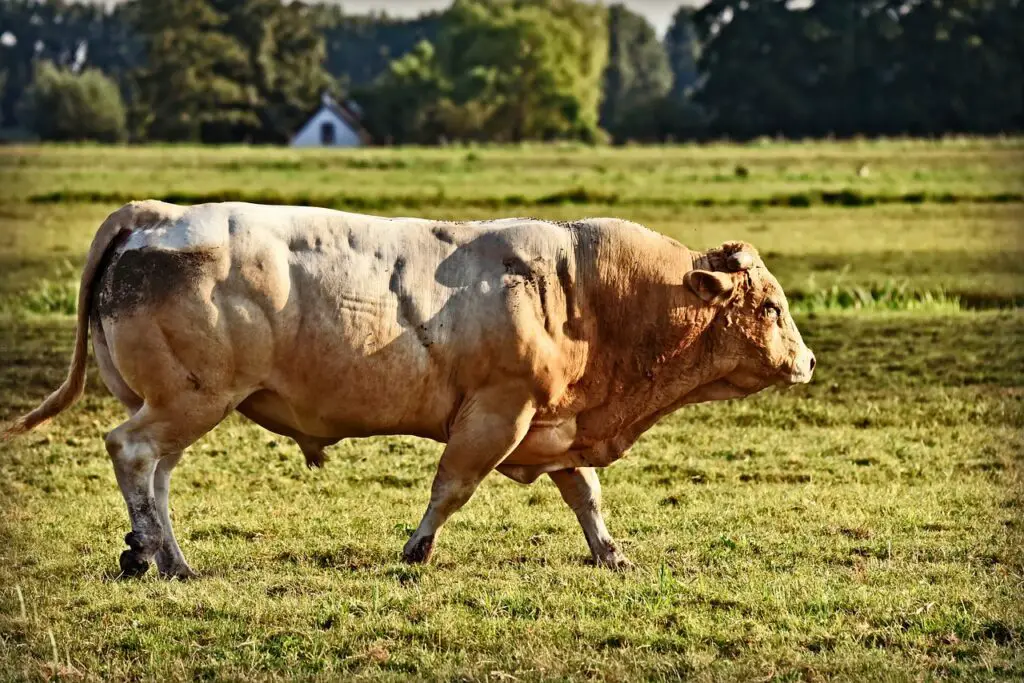
If you’ve ever seen a Belgian Blue cow, you probably did a double-take. These cattle are the undisputed bodybuilders of the bovine world, sporting incredibly muscular builds that seem to defy biology. But their eye-catching physiques come with a unique set of advantages and challenges. Let’s dive into the world of the Belgian Blue and discover what lies beneath those rippling muscles.
Origin
The Belgian Blue emerged in central and upper Belgium during the 19th century. Farmers selectively bred native cattle with imported Shorthorn and possibly Charolais breeds, aiming for improved beef production. Over time, Belgian scientists continued this quest for extreme musculature. In the mid-20th century, they honed in on the “double muscling” gene, which dramatically increases muscle development in this breed.
Characteristics
- Muscular Marvels: The most striking feature of Belgian Blues is their extraordinary muscle definition. They seem sculpted, with bulging shoulders, hindquarters, and even double-muscled necks!
- Size: They are large, with bulls reaching over 3000 lbs and cows easily topping 2000 lbs.
- Color: Belgian Blues come in various shades, including blue roan (a mix of blue-grey and white), white, and sometimes even black.
Advantages And Disadvantages of Belgian Blue Cattle
Advantages
- Exceptional Meat Yield: Belgian Blues offer a significantly higher percentage of lean meat compared to most other cattle breeds.
- Feed Efficiency: Their double muscling means they can gain muscle mass with less feed than conventional beef cattle breeds.
- Potential Tenderness: Some argue that Belgian Blue beef, when cooked correctly, can be surprisingly tender for its low-fat content.
Disadvantages
- Calving Difficulties: The breed has an extremely high rate of Cesarean sections due to the calves’ size and the cows’ less-roomy birth canal – often over 90% of births require surgical intervention.
- Potential Health Issues: There is some concern that Belgian Blues may be more susceptible to certain health problems due to their extreme muscle mass.
- Ethical Concerns: The focus on muscle development raises questions about animal welfare and whether it’s ethical to breed animals with traits that lead to health compromises.
Belgian Blue Cow
Cows of this breed are essential for reproduction but face unique challenges. They tend to have smaller pelvic openings and less maternal instincts than other beef breeds. This breeding focus makes them heavily dependent on human intervention in the birthing process.
Belgian Blue Bull
Belgian Blue bulls are prized for passing on their impressive muscle traits. However, there’s concern that selective breeding for extreme muscularity may negatively impact their fertility and overall health.
Characteristics Table
| Characteristic | Description |
|---|---|
| Color | White, blue roan, black, or combinations; sometimes red carrier |
| Heat Tolerance | Low to moderate, prefers temperate climates |
| Average Weight | Bulls: 2,200-2,750 lbs, Cows: 1,500-2,000 lbs |
| Size | Large-framed, exceptionally muscular |
| Temperament | Typically docile, but can be unpredictable during stress |
| Maternal Traits | Average mothering instincts, calving difficulties common due to large calves, often requiring caesarean section |
| Milk Production | Moderate, typically sufficient for calf rearing |
| Beef Production | Very high yield, exceptionally lean meat, low in fat and cholesterol |
| Other Notable Traits | “Double muscling” due to myostatin gene mutation, high feed efficiency, rapid growth |
FAQ
What are Belgian Blue cows used for?
They are primarily raised for their high-yield beef production.
Is Belgian Blue beef good?
Opinions vary – it’s very lean, with some finding it tough if not cooked carefully. It excels in some dishes but might not be the best for a juicy steak.
Why are Belgian Blue cows so muscular?
They have a genetic mutation of the myostatin gene, which inhibits muscle growth regulation. This leads to continuous muscle development.
What is the disadvantage of Belgian Blue cattle?
Major disadvantages include serious birthing difficulties, potential health concerns, and the ongoing ethical debate about their intensive breeding.
Conclusion
The Belgian Blue is undeniably a remarkable example of selective breeding. Their incredible musculature offers potential benefits in terms of meat production. However, the trade-offs are severe, including the near-total reliance on Cesarean births and ethical questions that can’t be overlooked.
Whether you find the breed fascinating or concerning, the Belgian Blue sparks an important discussion about the balance between human desires and the respect we owe to the animals we raise.
Have you ever encountered a Belgian Blue cow in person? What are your thoughts on this controversial breed? Share your views in the comments!
